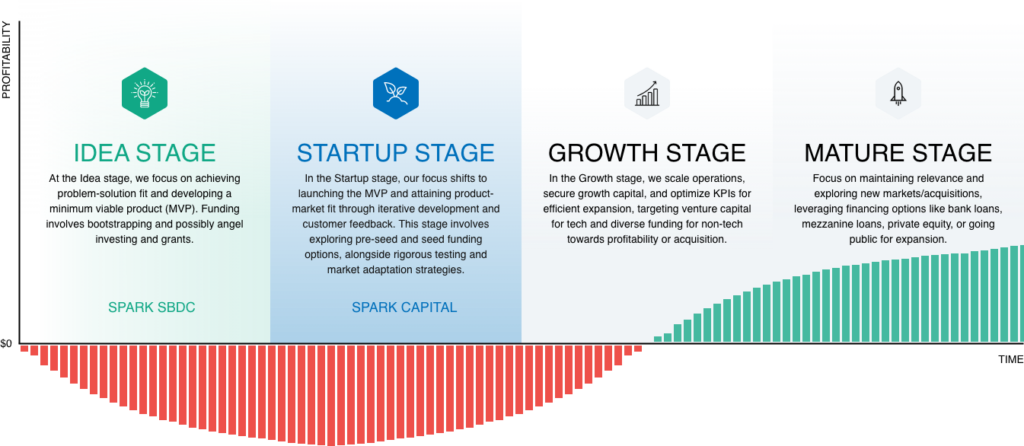
Are you looking for help launching a new product or service?
Ann Arbor SPARK can guide you through refining your idea and launching a business. The entrepreneurial services team has multiple programs and resources to help you get started, as well as affordable office space. Ann Arbor SPARK can help you find the funding you need to grow your company in Michigan.
Company Lifecycle and Funding Source
The company lifecycle graphic is an easy way to find the type of capital that’s appropriate for your stage. Whether you’re a high-tech startup seeking investment from an angel or venture capital investors, or a later-stage company seeking private equity or bank financing, SPARK can help you navigate the funding ecosystem in Michigan.

Please Note: The company lifecycle graphic is a simplification of capital markets and may not apply perfectly to each company or industry. For example, most angel and venture investors only invest in technology companies, not traditional businesses like restaurants, retail, or real estate.
What Stage are you?
Ann Arbor SPARK can help you find the funding you need to grow your company in Michigan. To see more about the different funding stages and how SPARK can help by selecting each stage below.

Idea Stage
Founders at this stage spend time and money to formulate their concept, conduct market research, identify target customers, and begin to develop their products or services. There won’t be many — if any — outside investors willing to bet on your new company at this point, so you’ll need to bootstrap, primarily with your own capital (i.e. savings, credit cards, personal loans, etc.). If you’re lucky, you might have some high-net-worth friends and family that are also willing to invest or loan you money. The good news is that if you’re able to successfully bootstrap through the idea stage, an increasing number of capital sources become available later.
Technology companies may have access to various grant funds, usually from public or nonprofit entities with technology commercialization missions, after you’ve made headway on your idea and developed an initial product.
Non-tech companies are unlikely to find grant funds and will need to rely on bootstrapping and producing revenue as soon as possible.

Startup Stage
You’ve done extensive product R&D, validated your business concept through customer discovery, and developed a prototype — ideally a Minimum Viable Product (MVP). The challenges of the startup stage are to commercialize the product or service, achieve Product Market Fit, and get traction with customers.
Technology companies in Michigan have access to multiple sources of capital at the startup stage. Non-tech companies do not qualify for these funding sources which focus on high-growth tech companies. Many small businesses will need to bootstrap through the startup stage, but some lending sources may open up depending on the company’s cash flow and collateral position.

Growth Stage
You’ve achieved product-market fit, have lots of demand, and you need funding to scale the business. The growth stage is where most venture capitalists invest in tech companies. Venture funds might invest tens of millions in a business, usually in increments (Series A, B, C, etc.) as a company meet milestones and overcomes risks.
The venture capital industry has grown significantly in Michigan over the past 20 years, and startup success stories over that period have attracted more out-of-state VCs to invest in Michigan companies.
Non-tech companies will have more access to funding during this stage, particularly after they’re profitable.

Mature Stage
Mature companies have gone through a growth stage and may be leveling off in terms of revenue and market share. Companies in this stage are often in mature industries and are now competing for market share with many other established firms. Mature companies still need capital for operations and in many cases to continue to grow in new ways.
Frequently Asked Questions
-
How can Ann Arbor SPARK help my company find funding?
Ann Arbor SPARK can guide you through the funding ecosystem in Michigan, helping you find the appropriate type of capital for your company’s stage, whether it’s angel investors, venture capital, private equity, or bank financing.
-
What are the different startup stages in terms of funding needs?
-
What funding sources are available at the Idea Stage?
-
What funding sources are available at the Startup Stage?
-
What funding sources are available at the Growth Stage?
-
What funding sources are available at the Mature Stage?

Share Your Business Idea
It all starts with an idea. Become a SPARK client to access grants, work with mentors, and more.
Contact the Capital Programs Team
Connect with the experts to learn more about raising capital or if you’re interested in supporting startups by becoming an angel investor.
Latest Funding
See our latest news:


